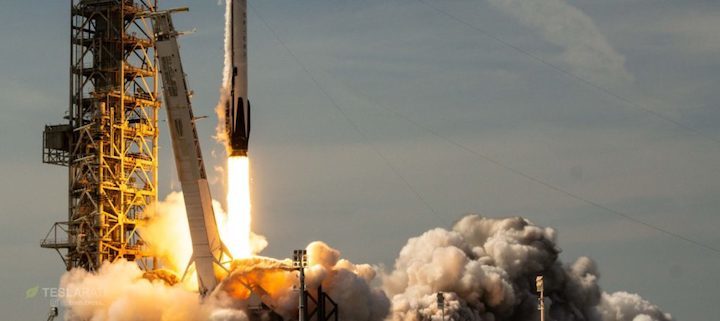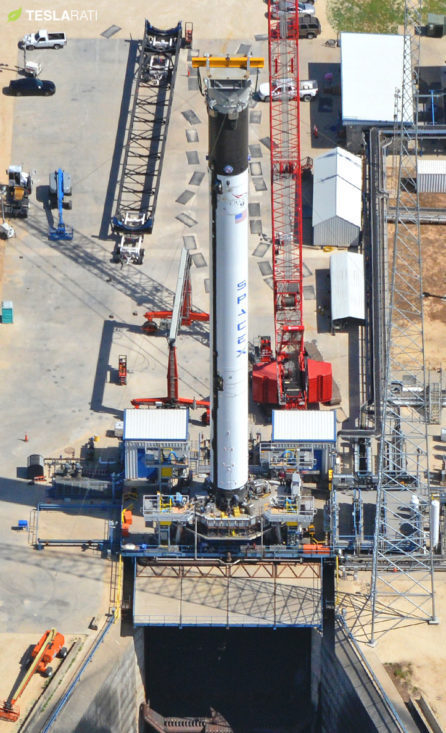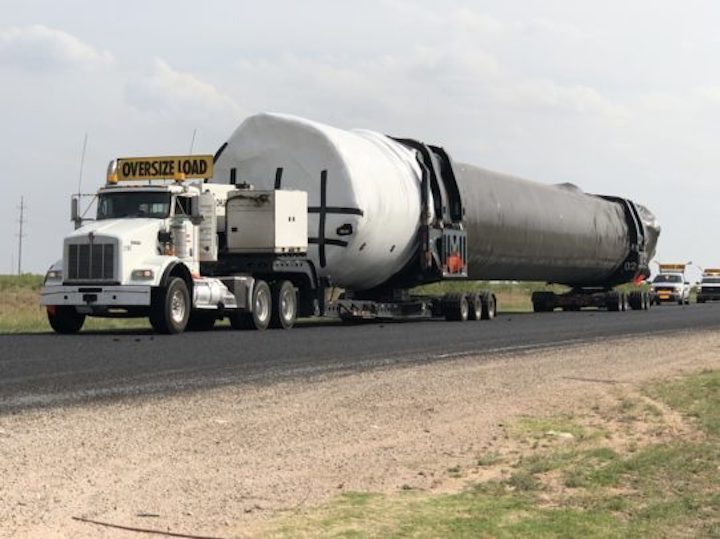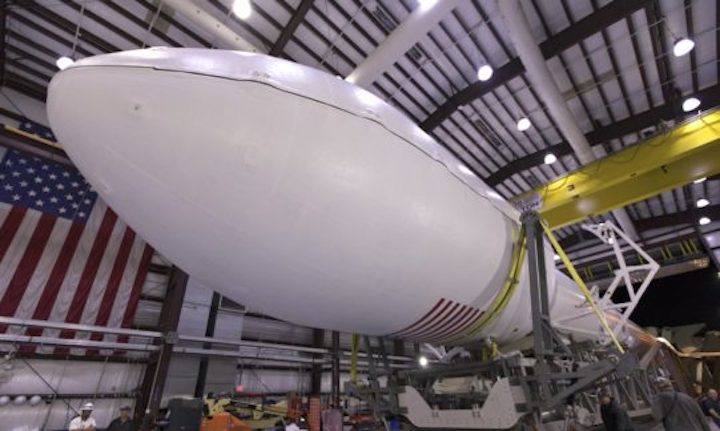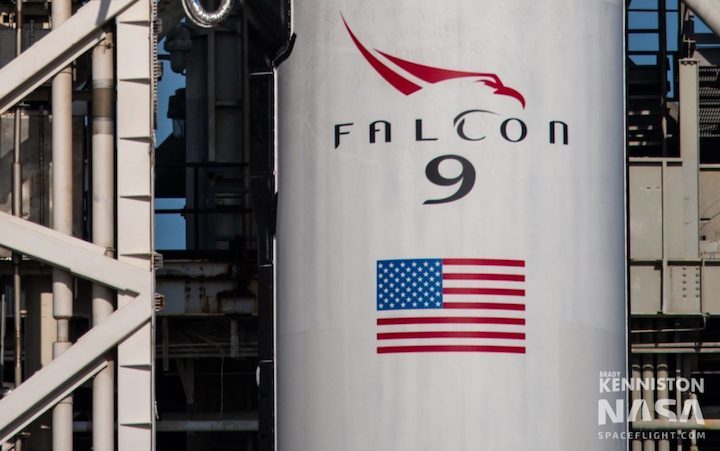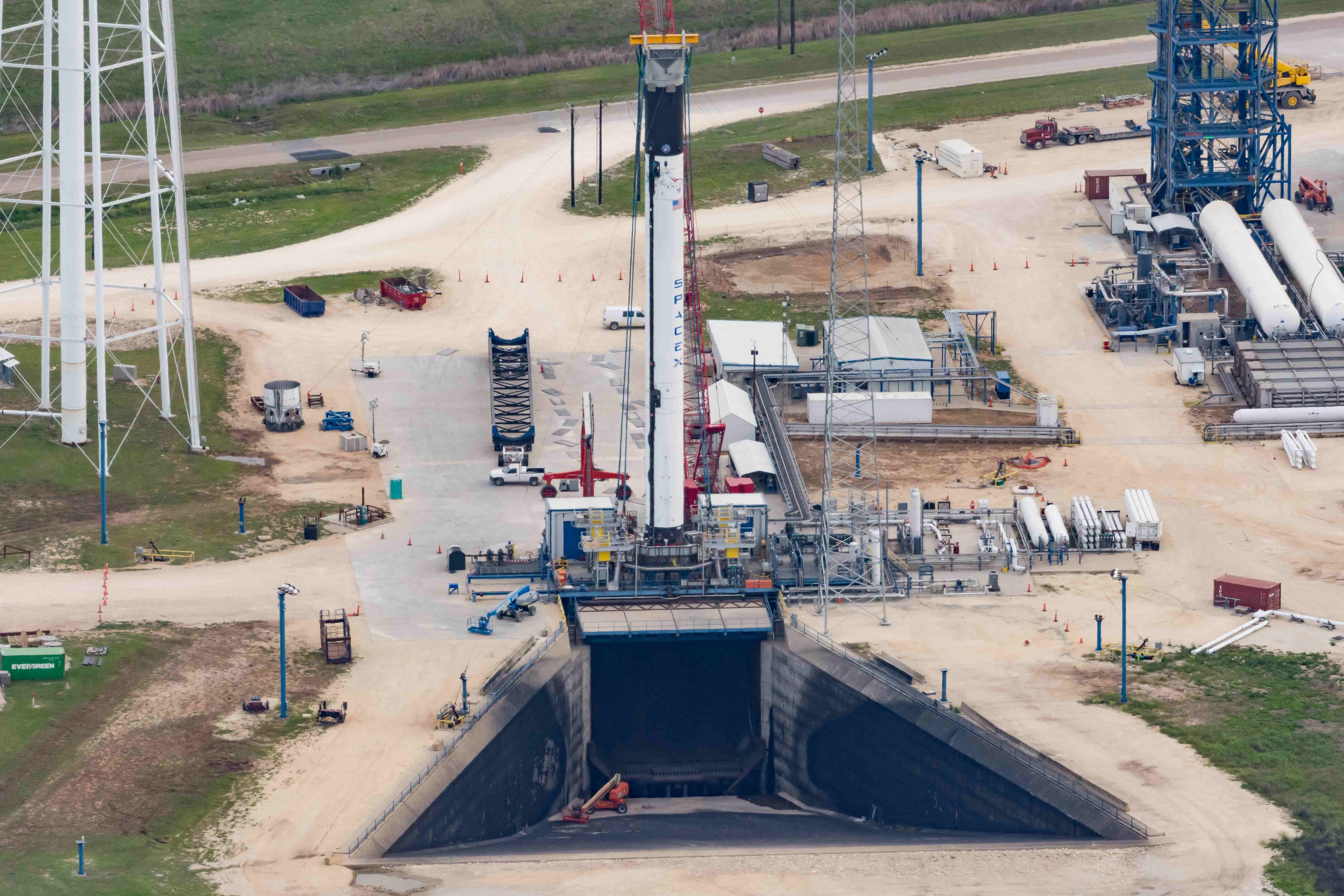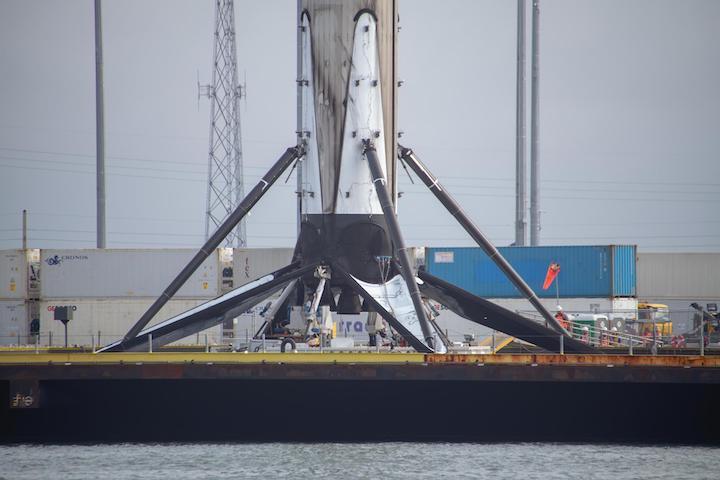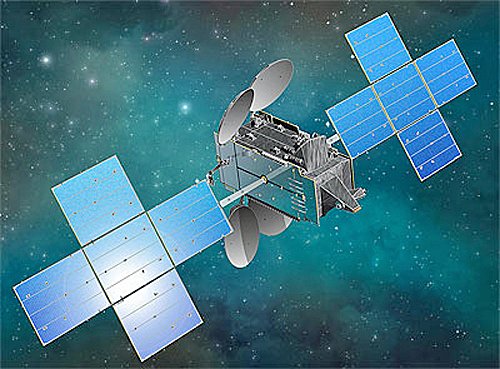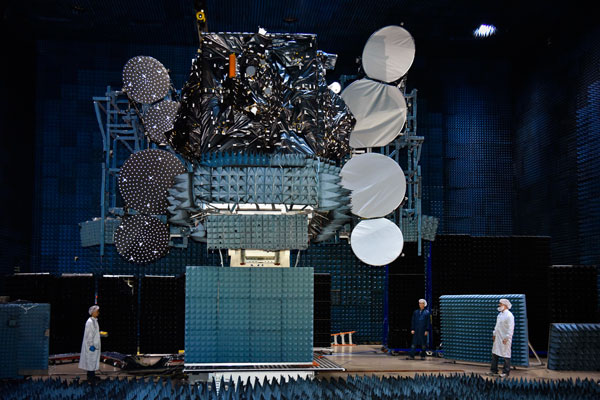
Telstar 19 VANTAGE shown in antenna testing at SSL in Palo Alto, Calif, before it was shipped to Cape Canaveral AFS. Photo: SSL / Telesat
With a successful test fire today of a SpaceX Falcon 9 ‘Block 5’ rocket at Cape Canaveral Air Force Station in Florida, it’s all system GO for launch of the next in a new generation of Telesat VANTAGE communication satellites called Telstar 19 VANTAGE. Liftoff from Launch Complex-40 is currently targeting July 22 at 1:50 a.m. EDT (05:50 UTC), with the launch window extending to 5:50 a.m. EDT. A backup launch date is scheduled for July 23 if needed.
Initial launch weather predictions from the U.S. Air Force 45th Space Wing suggest a 60% chance of favorable, but cloudy, conditions expected through the launch window, with “thick clouds” and “cumulous clouds” the main concerns on both nights.
Built by Space Systems Loral (SSL) in Palo Alto, CA, the new state-of-the-art, high throughput satellite (HTS) will be co-located with Telesat’s Telstar 14R satellite at 63 degrees West to serve Latin America, Northern Canada and mobile broadband requirements in the Caribbean and North Atlantic.
Designed for an in-orbit life of more than 15 years, Telstar 19 VANTAGE has two high throughput payloads, one in Ku-band and the other in Ka-band, to support a range of services, including advanced broadband connectivity for consumer, enterprise and mobility users. Based on the highly reliable SSL 1300 platform, which supports a broad range of applications and makes use of the latest technology advances, the satellite combines broad regional beams and powerful HTS spot beams enabling customers to “maximize throughput and spectral efficiency while optimizing network performance“.
“Hughes Network Systems LLC (Hughes) has made a significant commitment to utilize the satellite’s high throughput Ka-band capacity in South America to expand its broadband satellite services,” says Telesat. “The satellite has additional high throughput Ka-band capacity over Northern Canada, the Caribbean and the North Atlantic Ocean. It will also provide high throughput and conventional Ku-band capacity over Brazil, the Andean region and the North Atlantic Ocean.”
Bell Canada has signed a 15-year contract for substantially all of the HTS spot beam capacity over northern Canada on Telstar 19 VANTAGE, which will allow Bell Canada subsidiary Northwestel to dramatically enhance broadband connectivity for communities in Nunavut, Canada’s northernmost territory.
The mission will mark the second flight of SpaceX’s new ‘Block 5’ rocket, the final major evolution of their Falcon 9. Although visibly similar to its predecessors, standing 230 feet (70 meters) tall, the ‘Block 5’ is characterized by an approximately 7-8-percent thrust increase across all of its Merlin 1D+ engines, strengthened landing legs, improved reusability performance and enhanced flight control systems. Its design represents the culmination of years of development, incorporating many changes to allow SpaceX to refurbish and reuse their rockets much faster, and fly more missions with a single booster, all while keeping costs down.
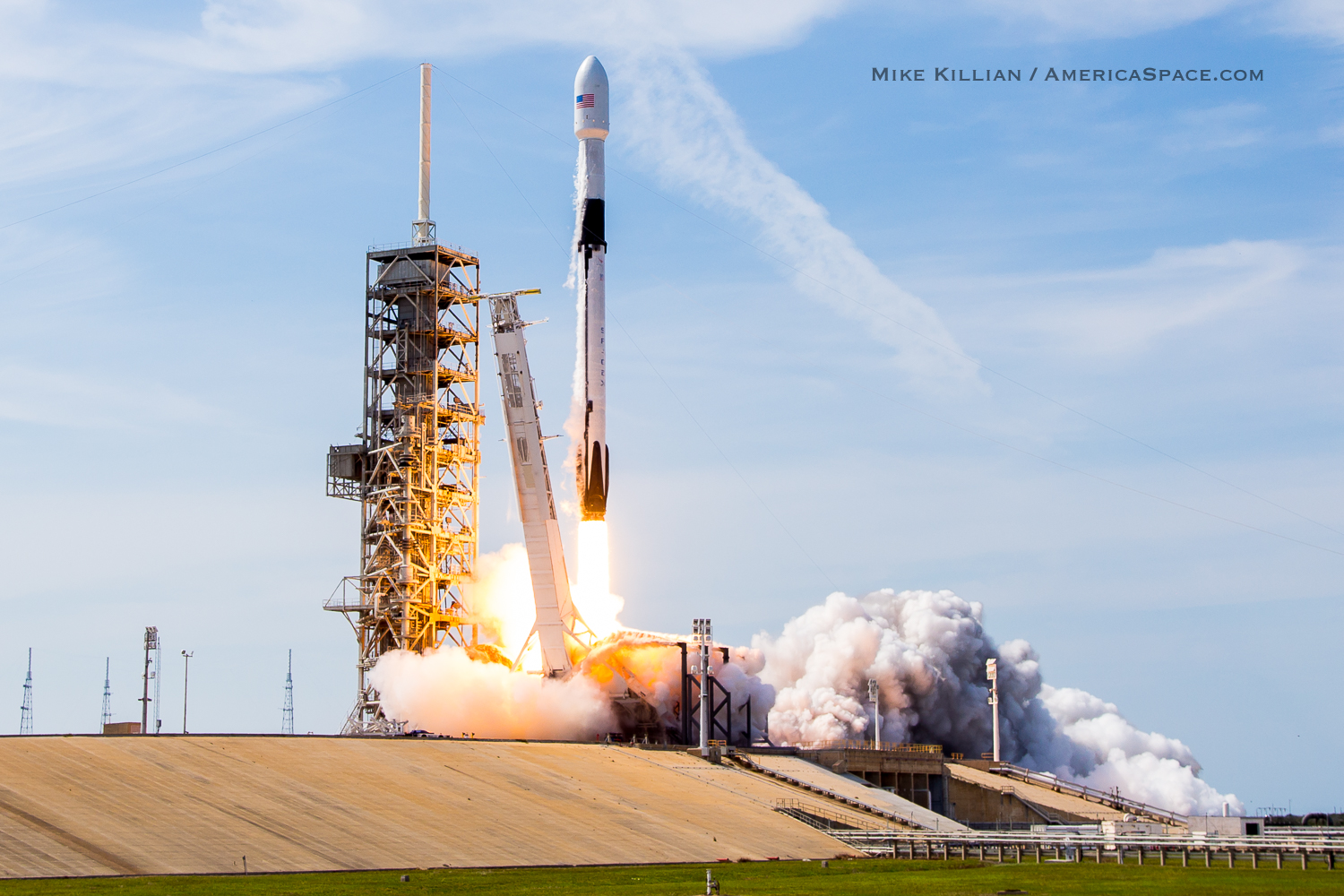
Launch of Bangabandhu 1 atop the first SpaceX ‘Block 5’ Falcon 9 rocket from KSC pad 39A on May 11, 2018. Photo Credit: Mike Killian / AmericaSpace
“The key to Block 5 is that it’s designed to do 10 or more flights with no refurbishment between each flight — or at least not scheduled refurbishment between each flight. The only thing that needs to change is you reload propellant and fly again,” said Elon Musk in a media teleconference last May.
“Our goal, just to give you a sense of how reusable we think the design can be, we intend to demonstrate two orbital launches of the same Block 5 vehicle within 24 hours, no later than next year. Toward the end of next year we’ll see the first Block 5 seeing [its] 10th flight. And like I said, next year is when we intend to demonstrate re-flight of the same primary rocket booster within — basically, same day re-flight of the same rocket. I think that’s really a key milestone,” he added.
But perhaps more importantly, the ‘Block 5’ is what NASA will certify to launch crews on. SpaceX needs to fly it in a “crew configuration” seven times before NASA will clear it to put their astronauts onboard. However, the rocket launching Sunday with Telstar 19 VANTAGE will not count towards that certification, and neither did the maiden flight of a ‘Block 5′ back on May 11, which launched the Bangabandhu-1 satellite for Bangladesh from Launch Complex 39A at Kennedy Space Center, because SpaceX has yet to implement a critical new design for the rocket’s second stage cryogenic helium pressurant tanks.
One of three composite overwrapped pressure vessels (COPVs) inside the second stage liquid oxygen (LOX) tank failed back in 2016, which led to an on-pad explosion of a Falcon 9 rocket back in 2016. COPVs are used to store cold helium which is used to maintain tank pressure.
NASA and SpaceX stated back in May that the first launch with the redesigned helium tanks won’t fly until Crew Dragon Demo-1, which was scheduled for August, but won’t fly now until at least the fall. Only then will NASA begin counting launches of ‘Block 5’ towards the 7-flights needed for crew certification.
As for the rocket launching Telstar 19 VANTAGE, it will aim to land on the company’s offshore autonomous spaceport drone ship (ASDS) shortly after launch.
Quelle: AS
---
Update: 22.07.2018 / 7.30 MESZ
.
Weather 60% GO for SpaceX Telstar 19 Launch Attempt Tonight from Florida
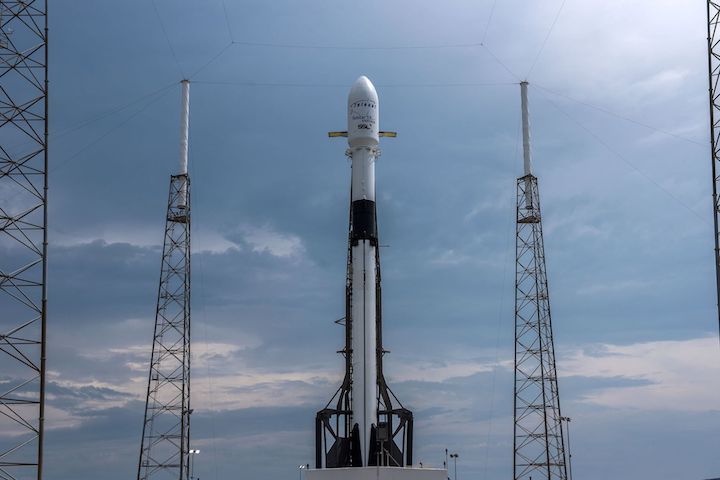
SpaceX is counting down to a launch attempt late tonight with their second Falcon 9 ‘Block 5’ rocket at Cape Canaveral Air Force Station in Florida, to deploy the next in a new generation of Telesat VANTAGE communication satellites to orbit called Telstar 19 VANTAGE. Liftoff from Launch Complex-40 is targeting July 22 at 1:50 a.m. EDT (05:50 UTC), with the launch window extending to 5:50 a.m. EDT. A backup launch date is scheduled for July 23 if needed.
Launch weather predictions from the U.S. Air Force 45th Space Wing have remained consistent all week, predicting a 60% chance of favorable, but cloudy, conditions expected through the launch window, with “thick clouds” and “cumulous clouds” the main concerns on both nights.
Built by Space Systems Loral (SSL) in Palo Alto, CA, the new state-of-the-art, high throughput satellite (HTS) will be co-located with Telesat’s Telstar 14R satellite at 63 degrees West to serve Latin America, Northern Canada and mobile broadband requirements in the Caribbean and North Atlantic.
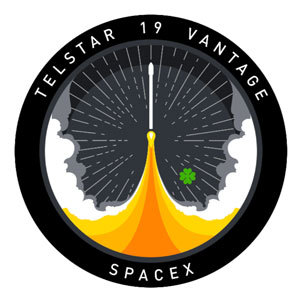

Telstar 19 VANTAGE shown in antenna testing at SSL in Palo Alto, Calif, before it was shipped to Cape Canaveral AFS. Photo: SSL / Telesat
Designed for an in-orbit life of more than 15 years, Telstar 19 VANTAGE has two high throughput payloads, one in Ku-band and the other in Ka-band, to support a range of services, including advanced broadband connectivity for consumer, enterprise and mobility users. Based on the highly reliable SSL 1300 platform, which supports a broad range of applications and makes use of the latest technology advances, the satellite combines broad regional beams and powerful HTS spot beams enabling customers to “maximize throughput and spectral efficiency while optimizing network performance“.
“Hughes Network Systems LLC (Hughes) has made a significant commitment to utilize the satellite’s high throughput Ka-band capacity in South America to expand its broadband satellite services,” says Telesat. “The satellite has additional high throughput Ka-band capacity over Northern Canada, the Caribbean and the North Atlantic Ocean. It will also provide high throughput and conventional Ku-band capacity over Brazil, the Andean region and the North Atlantic Ocean.”
Bell Canada has signed a 15-year contract for substantially all of the HTS spot beam capacity over northern Canada on Telstar 19 VANTAGE, which will allow Bell Canada subsidiary Northwestel to dramatically enhance broadband connectivity for communities in Nunavut, Canada’s northernmost territory.
The mission will mark the second flight of SpaceX’s new ‘Block 5’ rocket, the final major evolution of their Falcon 9. Although visibly similar to its predecessors, standing 230 feet (70 meters) tall, the ‘Block 5’ is characterized by an approximately 7-8-percent thrust increase across all of its Merlin 1D+ engines, strengthened landing legs, improved reusability performance and enhanced flight control systems. Its design represents the culmination of years of development, incorporating many changes to allow SpaceX to refurbish and reuse their rockets much faster, and fly more missions with a single booster, all while keeping costs down.
But perhaps more importantly, the ‘Block 5’ is what NASA will certify to launch crews on. SpaceX needs to fly it in a “crew configuration” seven times before NASA will clear it to put their astronauts onboard. However, the rocket launching Sunday with Telstar 19 VANTAGE will not count towards that certification, and neither did the maiden flight of a ‘Block 5′ back on May 11, which launched the Bangabandhu-1 satellite for Bangladesh from Launch Complex 39A at Kennedy Space Center, because SpaceX has yet to implement a critical new design for the rocket’s second stage cryogenic helium pressurant tanks.
One of three composite overwrapped pressure vessels (COPVs) inside the second stage liquid oxygen (LOX) tank failed back in 2016, which led to an on-pad explosion of a Falcon 9 rocket back in 2016. COPVs are used to store cold helium which is used to maintain tank pressure.
NASA and SpaceX stated back in May that the first launch with the redesigned helium tanks won’t fly until Crew Dragon Demo-1, which was scheduled for August, but won’t fly now until at least the fall. Only then will NASA begin counting launches of ‘Block 5’ towards the 7-flights needed for crew certification.
As for the rocket launching Telstar 19 VANTAGE, it will aim to land on the company’s offshore autonomous spaceport drone ship (ASDS) shortly after launch.
Quelle: AS
+++
LIVE-Frams von SpaceX Falcon-9 Launch
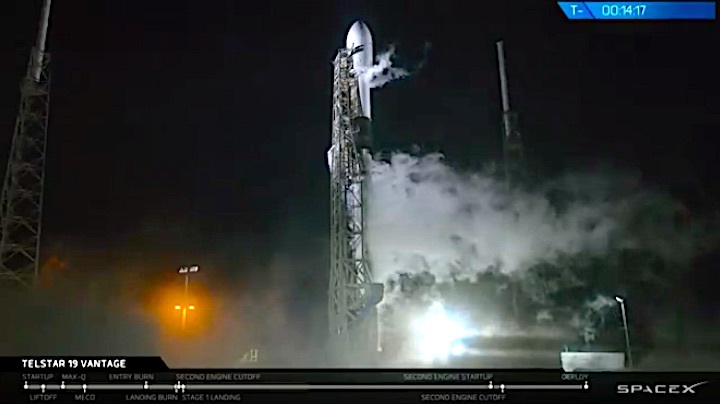
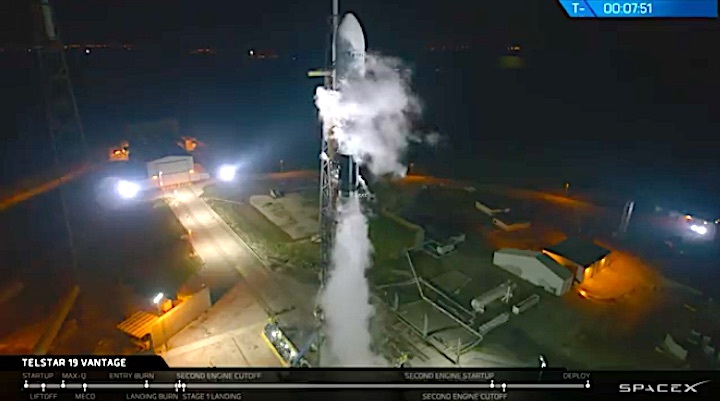
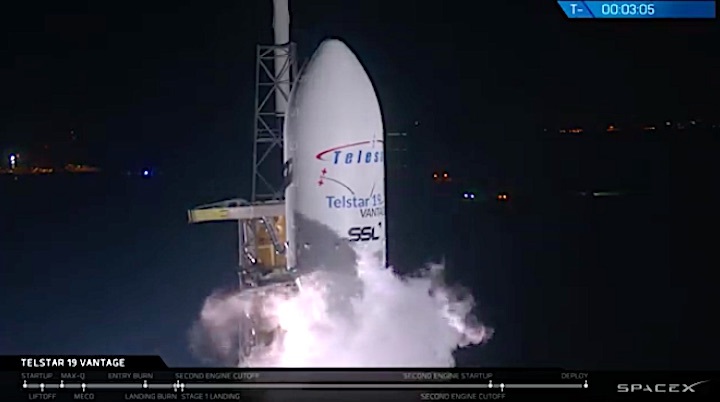
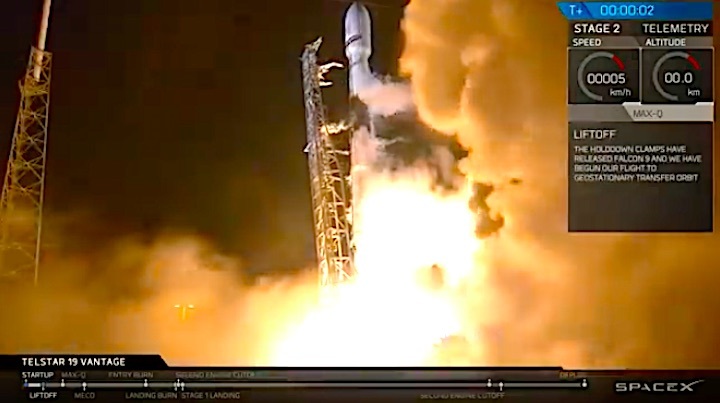
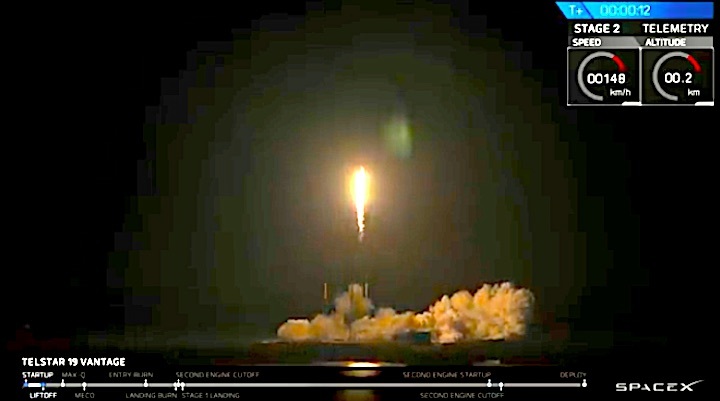
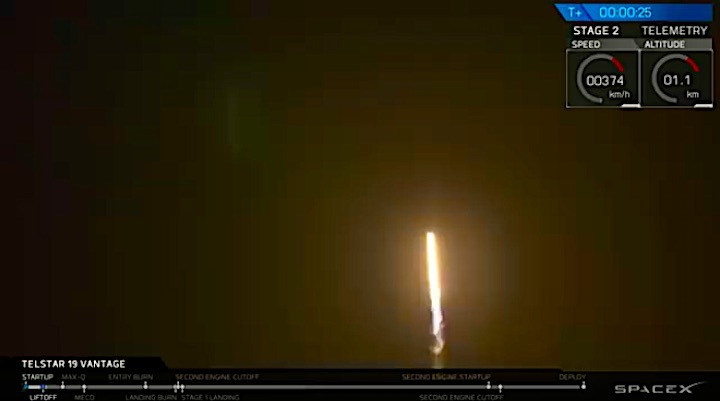
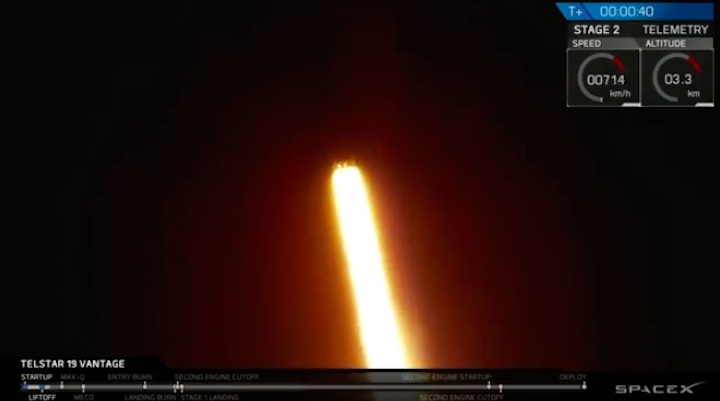
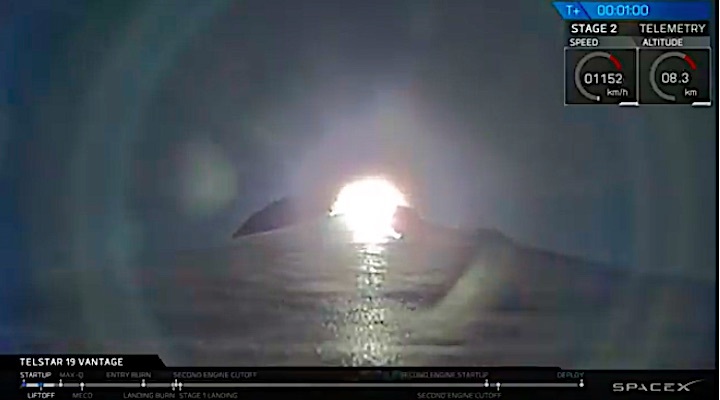
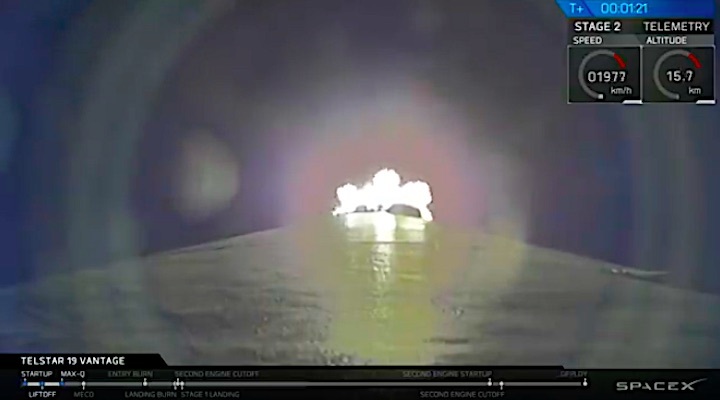
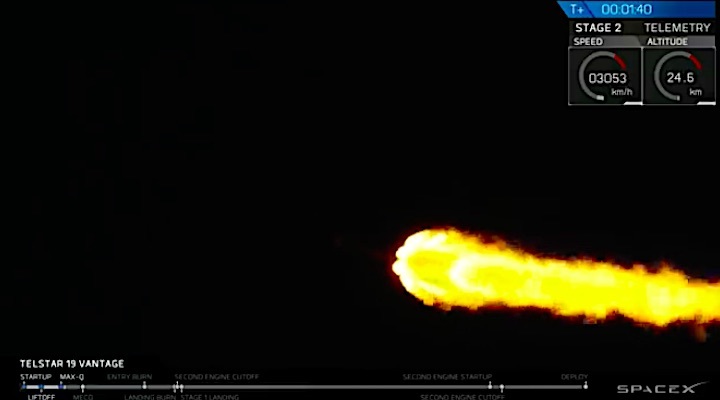
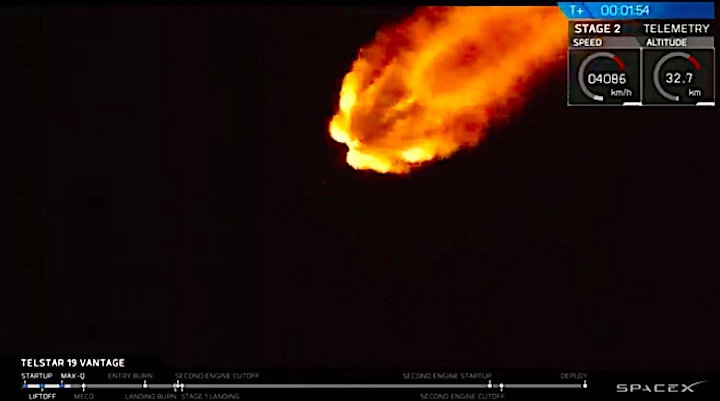
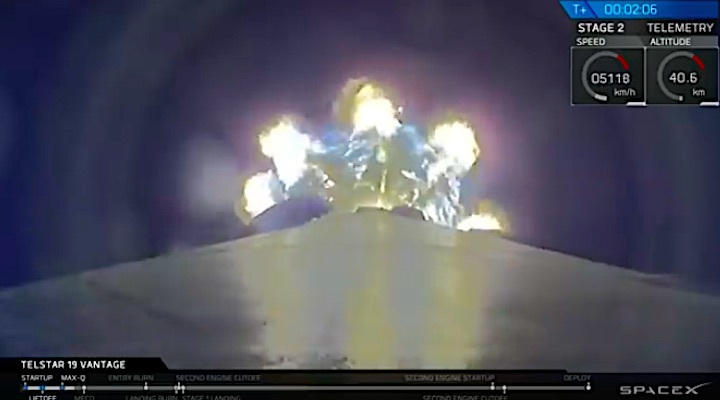
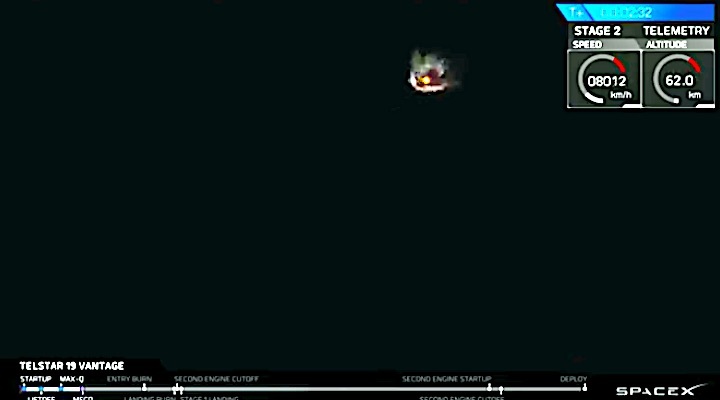
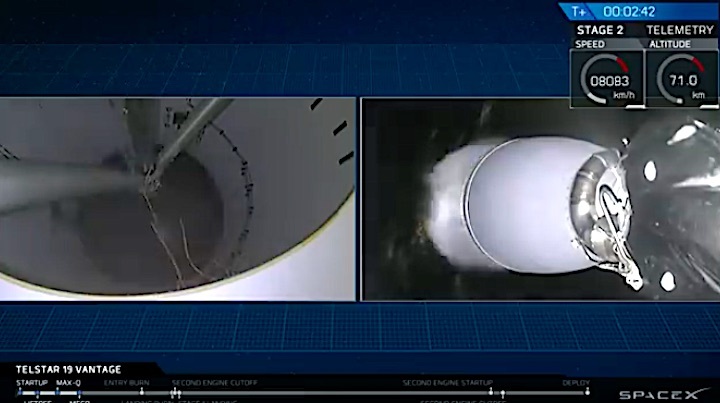
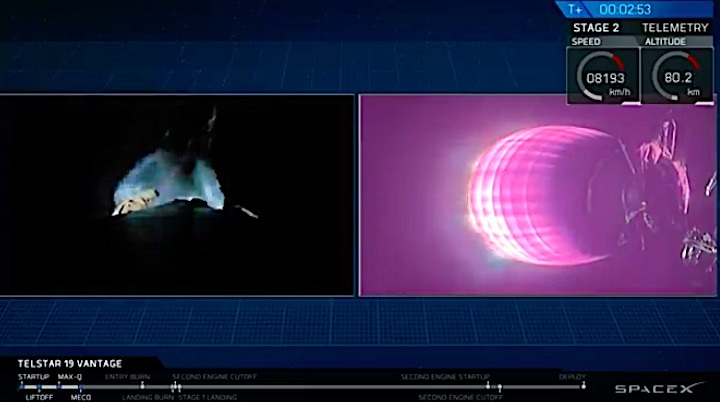
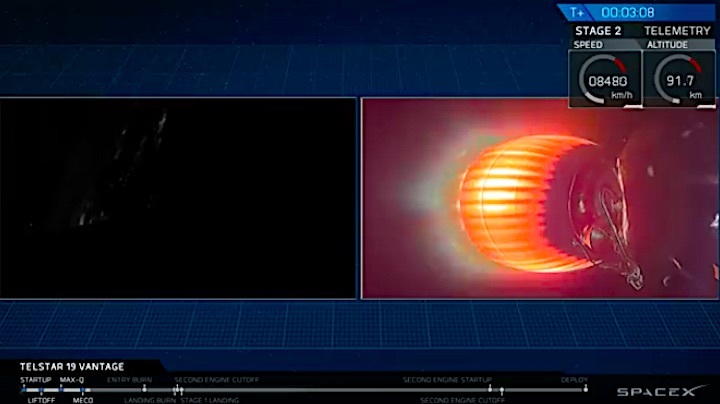
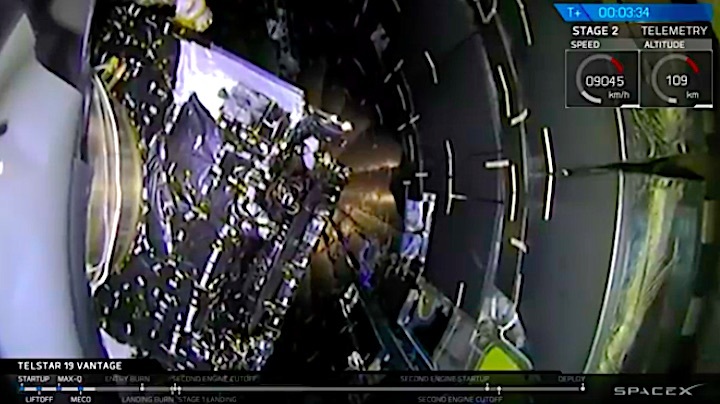
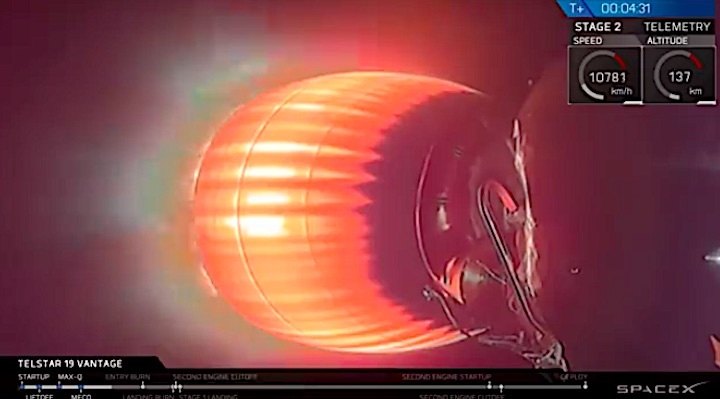
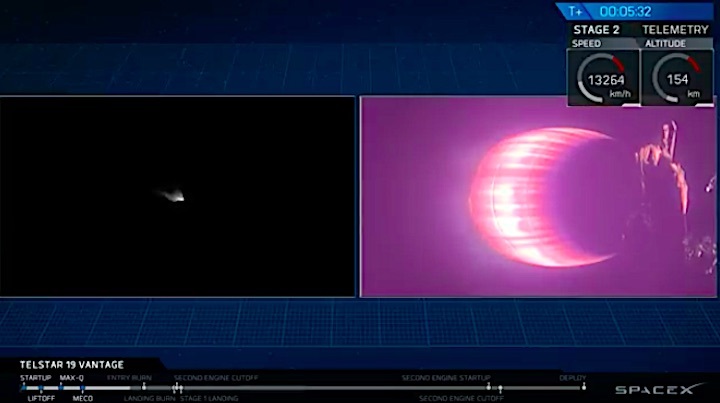
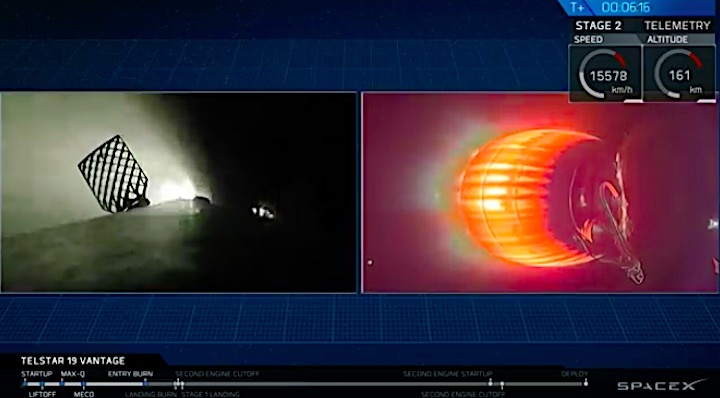
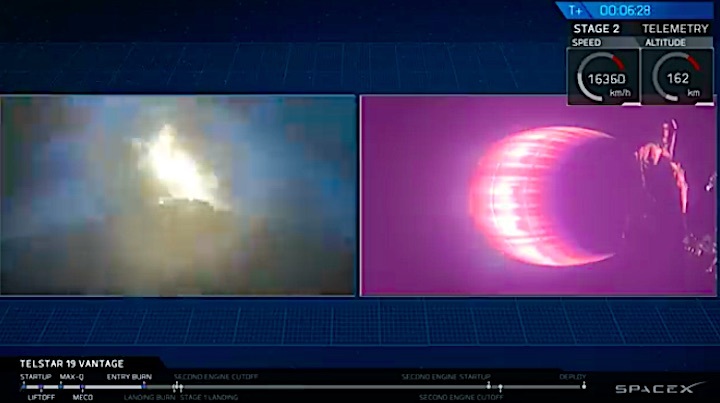
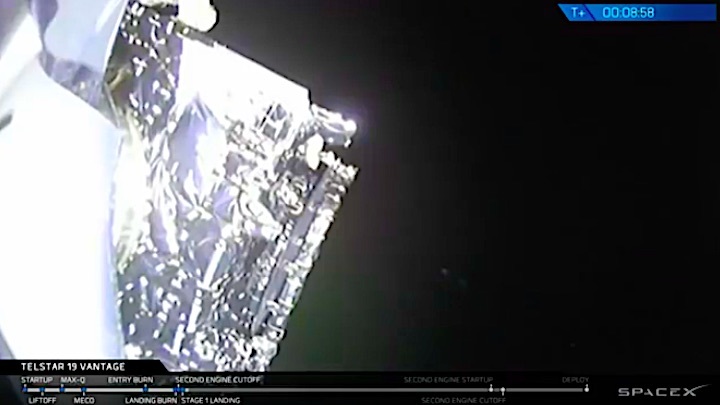
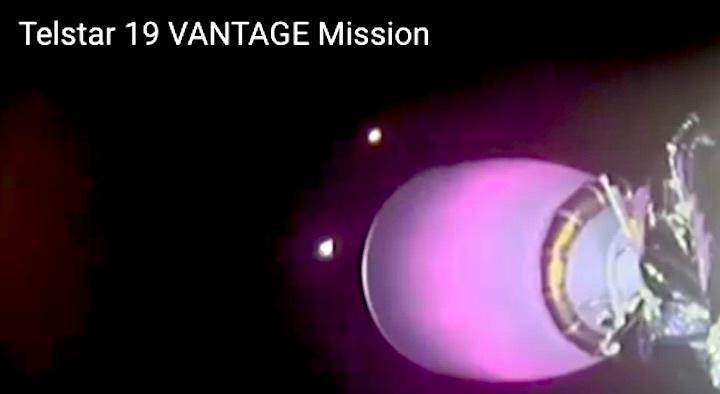
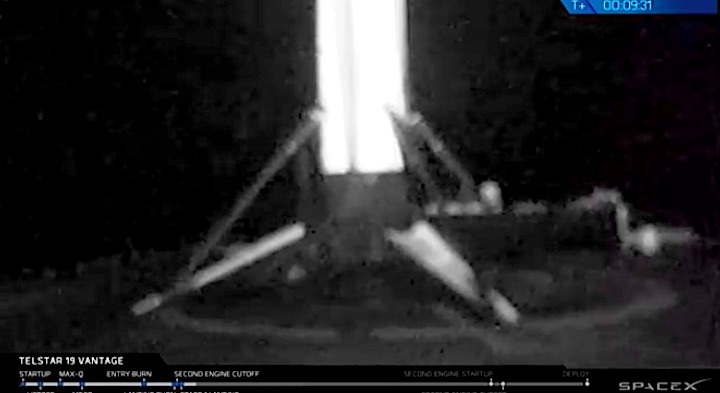
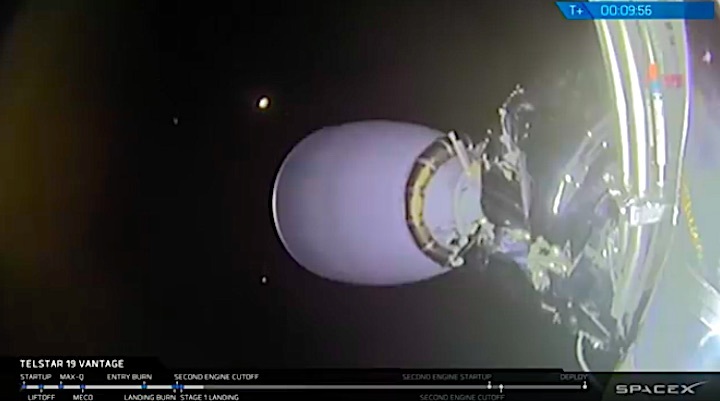
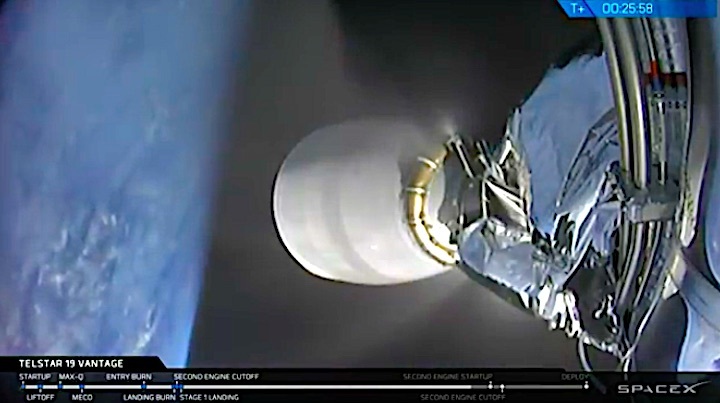
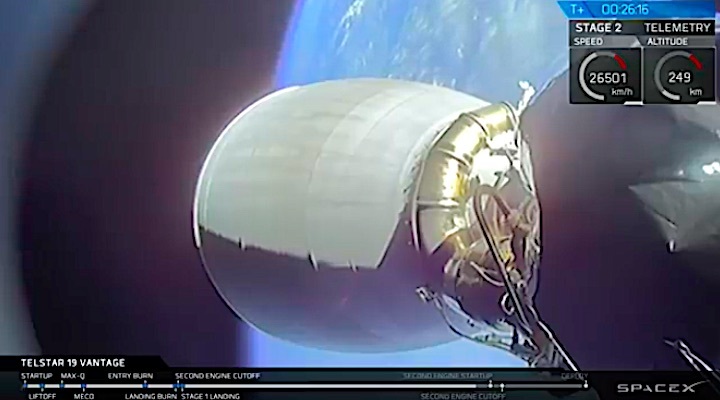
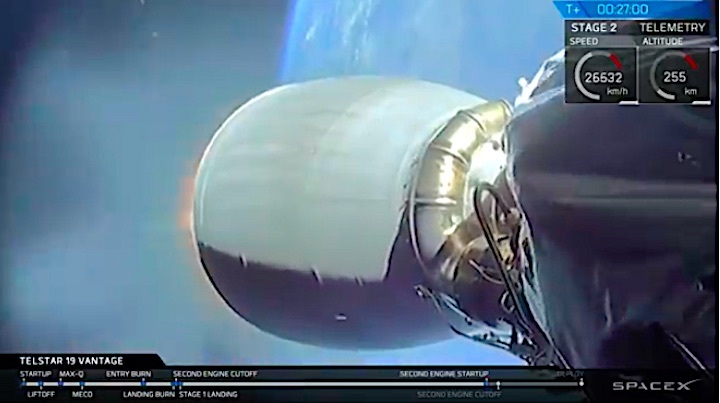
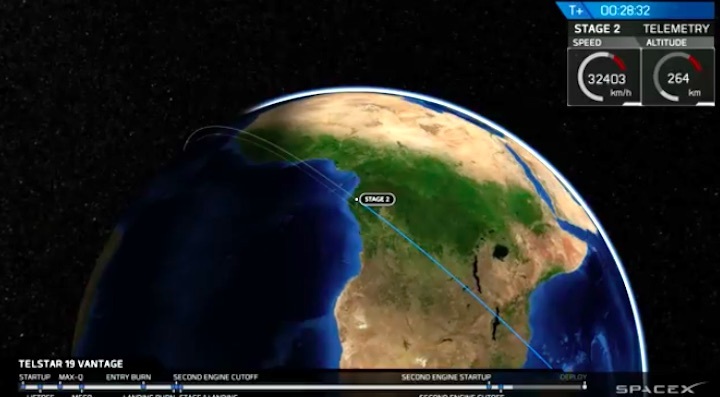
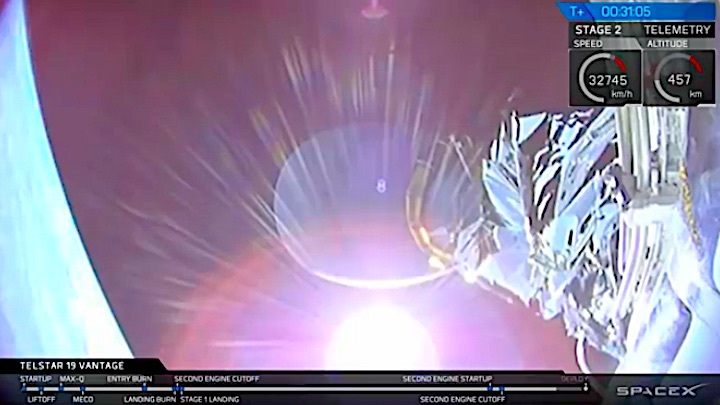
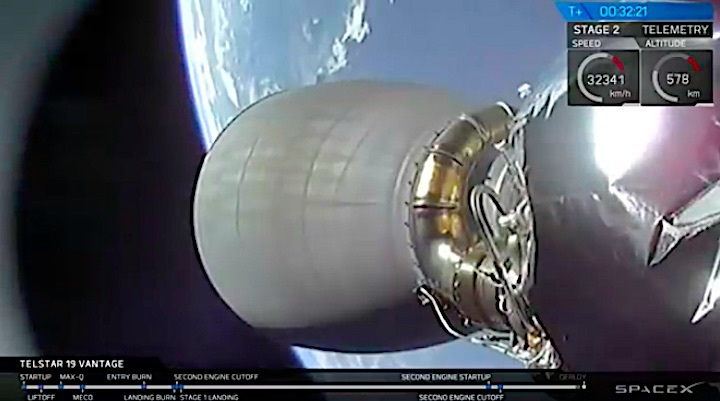
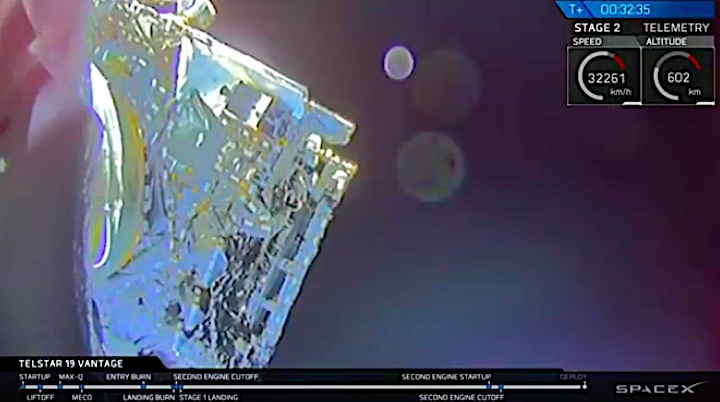
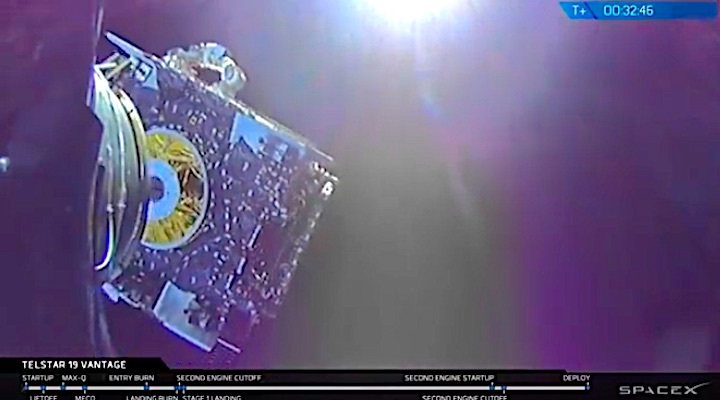
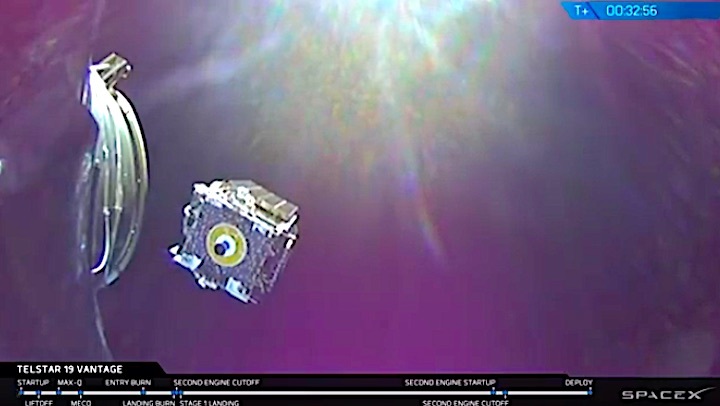
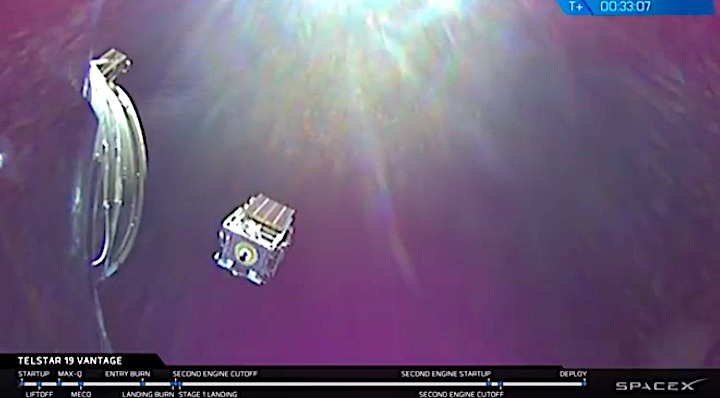
Quelle: SpaceX

